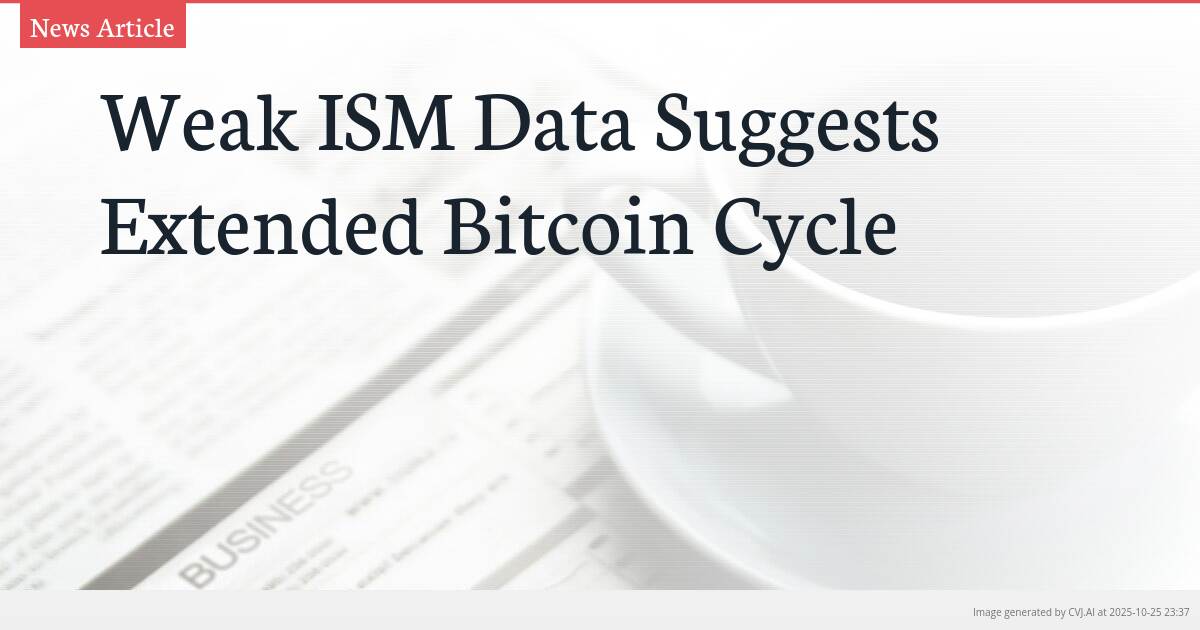This summary text is fully AI-generated and may therefore contain errors or be incomplete.
Introduction
Bitcoin’s market cycles could be longer than expected as weak ISM manufacturing data signals persistent macroeconomic headwinds. Historical patterns show Bitcoin’s price peaks have consistently aligned with cyclical highs in the Purchasing Managers’ Index. This correlation, popularized by macro analysts, suggests the current cycle may extend beyond typical durations.
Key Points
- Historical correlation shows Bitcoin's three previous cycle tops aligned with ISM PMI peaks
- Weak manufacturing data suggests extended macroeconomic headwinds affecting crypto markets
- Analysis popularized by Raoul Pal has gained traction among macro-focused crypto analysts
The Historical Correlation Between ISM PMI and Bitcoin Cycles
The relationship between the Institute for Supply Management’s Manufacturing Purchasing Managers’ Index (PMI) and Bitcoin’s market cycles has emerged as a significant pattern in macroeconomic analysis of cryptocurrency markets. According to historical data, all three previous Bitcoin cycle tops have broadly aligned with peaks in this monthly, oscillating economic indicator. This correlation was first popularized by Real Vision’s Raoul Pal and has since gained substantial traction among macro-focused crypto analysts who monitor traditional economic signals for cryptocurrency market insights.
Analyst Colin Talks Crypto has specifically noted the recurring overlap between Bitcoin’s market highs and the PMI’s cyclical peaks, highlighting how this pattern has persisted across multiple market cycles. The ISM PMI serves as a crucial barometer of United States manufacturing health, measuring factors such as new orders, production, employment, and supplier deliveries. When this indicator reaches cyclical highs, it has consistently coincided with periods when Bitcoin approaches market tops, suggesting a fundamental connection between manufacturing sector strength and cryptocurrency market cycles.
Current Weak Manufacturing Data and Macroeconomic Implications
The current weakness in ISM manufacturing data points to extended macroeconomic headwinds that could significantly impact Bitcoin’s market trajectory. As the PMI remains subdued, it indicates slower business recovery and persistent challenges in the manufacturing sector, which historically correlates with extended cryptocurrency market cycles. This pattern suggests that Bitcoin may experience a longer-than-usual cycle duration before reaching its next market peak.
The correlation between weak manufacturing data and extended Bitcoin cycles reflects the broader relationship between traditional economic indicators and cryptocurrency market behavior. When the ISM PMI shows sustained weakness, it typically signals broader economic challenges that can affect investor sentiment, risk appetite, and capital flows into alternative assets like Bitcoin. This dynamic creates an environment where cryptocurrency markets may take longer to complete their typical cycle patterns, as macroeconomic conditions continue to exert influence on price movements and market psychology.
Analytical Framework and Market Implications
The analytical framework connecting ISM PMI data to Bitcoin market cycles provides valuable insights for investors and traders monitoring cryptocurrency markets. This correlation, as highlighted by Raoul Pal and supported by analysts like Colin Talks Crypto, offers a macroeconomic lens through which to view Bitcoin’s price movements. The pattern suggests that manufacturing sector strength, as measured by the PMI, serves as a reliable indicator of broader economic conditions that influence cryptocurrency market cycles.
For market participants, the current weak ISM data implies that Bitcoin may experience an extended cycle with potentially slower recovery phases. This analysis suggests that investors should monitor manufacturing data as part of their broader market assessment, recognizing that sustained PMI weakness could delay the timing of Bitcoin’s next market peak. The correlation between these economic indicators and cryptocurrency markets underscores the growing integration of digital assets within the global financial system and their sensitivity to traditional macroeconomic forces.
As the relationship between ISM PMI data and Bitcoin cycles continues to be observed and analyzed, it provides a valuable tool for understanding how cryptocurrency markets interact with broader economic trends. This correlation not only helps explain historical market patterns but also offers guidance for anticipating future market developments, particularly in periods of economic uncertainty or manufacturing sector weakness that may extend the duration of Bitcoin’s market cycles beyond typical expectations.
📎 Read the original article on cointelegraph.com

